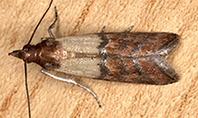
Pheromone Chemicals
Manufacturers of Pheromone Traps & Lures





Plodia interpunctella
(Indian meal moth) – Main pest of storage seeds, Maize, cereals, Spices, bird seed, rice, groundnuts and has presence all over the world. The Indian meal moth is a very common household and retail pest of stored food products, particularly cereal products.
Life cycle :
Females start laying eggs up to 400
eggs into or adjacent to food within 3 days of emergence, usually at night. Within a few hours of
hatching, larvae (which are external feeders) begin to feed, trailing a silken thread.
There are 5-7 larval instars. The last instar larvae may enter diapause In temperate or cooler
areas and remain inactive for several months until conditions improve. Moth will emerge in
Spring when temperature and day length have increased.
Adults do not feed and are generally short-lived - around 7 days. Optimum conditions for
development are around 30-35oC and 70-80%RH but infestations may be sustained at
temperatures as low as 15oC and relative humidity of 25%. The shortest incubation time for eggs
is 4-5 days, but the time for full development depends on food source and other variables. The
maximum rate of population increase is about 60 times per month. Larvae develop more easily
on broken seeds rather than whole ones as the pericarp offers a barrier to attack by larvae.
Host plants :
Maize, cereals, Spices, bird seed, groundnuts and has presence all over the world.
Damage :
Larva causes serious damage to ear and grain of maize; contaminates the grain with excreta, cast skins, webbings, dead individuals and cocoons; prefers to eat the germ portion and hence grains lose viability. Most of the damage to stored products occurs when the larvae spin massive amounts of silk that accumulate faecal pellets, cast skins, and egg shells in food products. Damage due to this contamination exceeds the amount of food eaten by the larvae It feeds superficially but may construct more than one silken tunnel. The presence of silken threads or clumps or food particles in a processed cereal product such as white rice or rolled oats usually indicates a larval infestation of Plodia interpunctella. Plodia interpunctella is attracted to food sources by food odors.
ETL for Plodia interpunctella is 6-8 No’s of moths per trap per day.
Use 8 No’s Pheromone Traps per acre from one month crop stage to control pest at early stage.
Trap canopy should be placed one feet above crop canopy to achieve optimum catch.
Recommended trap model: Phero-Sensor™-SP (for dusty areas and godowns) or
Phero-Sensor™ - Delta Trap (for residential areas)
Recommended for: Storage areas of grains or seeds belonging to Maize, cereals, Spices, bird seed, rice, groundnuts….etc..
© 2020 Pheromone Chemicals. All Rights Reserved | Powered by: Raviteja Designs